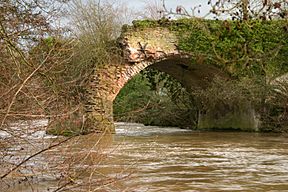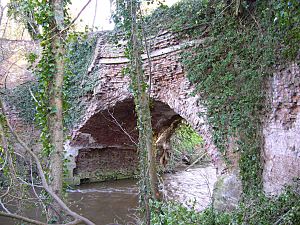Leominster Canal facts for kids
The Leominster Canal was a waterway in England. It stretched for about 18 miles (29 km). The canal connected the towns of Mamble and Leominster. Along its route, it had 16 locks and several tunnels. Some tunnels had problems even before the canal opened. This canal was originally part of a much bigger plan. The idea was to build a 46-mile (74 km) canal. It would have linked Stourport to Kington.
Contents
Building the Leominster Canal
Early Plans and Ideas
After the Staffordshire and Worcestershire Canal opened in 1772, people had new ideas. This canal connected the busy Midlands to the River Severn. In 1777, an engineer named Robert Whitworth suggested a new canal. It would link Stourport to Hereford, passing through Pensax and Leominster.
Meetings were held in 1789 to discuss this idea. People in Leominster and Tenbury Wells wanted to find the best route. Thomas Dadford, Jr. surveyed the area. In December 1789, he showed a plan for a 31-mile (50 km) canal. He estimated it would cost £83,000. He thought it could earn £4,300 each year. This plan included three tunnels at Putnal Field, Southnet, and Pensax.
Starting Construction
Even though the expected earnings were low, people decided to build Dadford's canal. This decision was made in January 1790. Later, in April, a meeting in Kington added another idea. They wanted a canal connecting to Kington too. So, the two plans became one big project. The total canal length would be 46 miles (74 km).
From Kington, the canal would go up 48 feet (15 m) using locks. Then, it would drop 496 feet (151 m) to reach the River Severn. People didn't seem worried about the lack of big towns or industries nearby. An Act of Parliament was passed on May 13, 1791. This law allowed the canal owners to raise £150,000. They could raise another £40,000 if needed.
Dadford became the main engineer. He worked on the Leominster Canal until 1795. However, he only spent a quarter of his time on this project. He also worked on the Monmouthshire Canal.
Building Challenges and Delays
Work on the canal started soon after Dadford was hired. By October 1794, a section was open. This part ran from Woofferton (near Tenbury) to Marlbrook (near Mamble). The next year, most of the section from Leominster to Woofferton was finished.
Beyond Marlbrook, the 1,254-yard (1,147 m) Southnet tunnel was completed. Work also began on an aqueduct over the River Lugg at Kingsland. About £90,000 had been spent by this point.
However, there were big problems with the Southnet tunnel. Part of it collapsed in 1795. The canal owners asked John Rennie for advice. He criticized Dadford's work. Rennie estimated it would cost £20,000 to fix the existing parts. He also said another £135,937 was needed to finish the whole project.
Despite these issues, the owners got a second Act of Parliament. This was on April 26, 1796. It allowed them to raise or borrow another £180,000. The 330-yard (300 m) tunnel at Putnall Fields was very hard to build. It was finally finished in July 1796. This completed the route to Leominster. The working canal was now 18.5 miles (29.8 km) long.
On June 1, 1797, a special ceremony took place. It was where the canal was supposed to join the River Severn. But only £62,582 had been raised from the second Act. With about £25,000 still owed, all work stopped.
Later Ideas for Completion
In 1803, the owners asked John Hodgkinson for advice. He was a railway engineer. He suggested building railways at each end of the existing canal. These railways would connect to Kington and Stourport. Another Act of Parliament was passed for this, but no work happened.
Nine years later, they asked Hodgkinson again. This time, he suggested giving up on the Stourport route. Instead, he proposed extending the canal to the River Severn at Worcester. This plan also never happened.
How the Canal Was Used
In January 1794, the canal opened from Marlbrook to Woofferton. On the first day, seven boatloads of coal were moved from the Mamble collieries (coal mines). Building problems delayed the opening of Putnall Tunnel until 1796.
By the end of 1796, an 18.5-mile (29.8 km) part of the canal was open. It ran between Marlbrook and Leominster. On the first day, 14 boatloads of coal arrived in Leominster. Coal from the Mamble collieries came down a hill on tramways. It was loaded onto barges at Southnet wharf. Then, it was taken to Leominster by canal.
For the next 60 years, the canal carried coal to Leominster. This helped the Mamble collieries to do well. However, the amount of coal moved was not enough. The canal owners struggled to make a profit. They kept trying to extend the canal eastwards to the River Severn. But this never happened.
End of the Canal
The Leominster Canal never made enough money to pay back its investors. Most of the money it collected came from tolls on coal transport. In 1858, the Shrewsbury and Hereford Railway bought the canal. They paid £12,000 for it. This meant each £100 share was worth only £16. The railway company soon drained the canal to sell the land.
Part of the canal's route was later used for a railway line. This was the Tenbury and Bewdley Railway. It connected Woofferton to Bewdley through Tenbury Wells station.
What Remains Today
Even though the canal closed over 150 years ago, some parts are still left. You can see an aqueduct over the River Rea. There are also parts of a 3-arched aqueduct over the River Teme. The middle arch of the Teme aqueduct was destroyed. This happened during an explosives exercise in the Second World War. But the remaining parts became a Grade II listed structure in 2000. This means it's a building of special historical interest.
The Rea aqueduct had a single brick arch. It was 45 feet (14 m) wide. It carried the canal in a brick-lined trough. People thought it was the largest brick arch when it was built. Like the Teme aqueduct, it was also Grade II listed in 2000. It became a public footpath across the River Rea. However, the path was closed in 2014. This was because part of the canal trough collapsed.
The Friends of the Leominster Canal is a charity (number 1113746). They organize regular walks and visits to the canal and its remaining features.
Places of Interest Along the Canal
| Point | Coordinates (Links to map resources) |
OS Grid Ref | Notes |
|---|---|---|---|
| Stourport | 52°20′31″N 2°17′47″W / 52.3419°N 2.2965°W | SO798715 | proposed end point |
| Wharf House, Southnet | 52°19′51″N 2°29′16″W / 52.3308°N 2.4877°W | SO668704 | |
| Rea aqueduct | 52°19′47″N 2°30′48″W / 52.3298°N 2.5134°W | SO651703 | |
| Railway cutting near Newnham | 52°19′29″N 2°31′11″W / 52.3248°N 2.5196°W | SO646697 | Newnham tunnel? |
| Railway near Tenbury | 52°19′08″N 2°35′04″W / 52.3190°N 2.5844°W | SO602691 | Followed line of canal |
| Teme aqueduct | 52°18′55″N 2°40′51″W / 52.3153°N 2.6807°W | SO536687 | |
| Route through Woofferton | 52°18′57″N 2°42′39″W / 52.3158°N 2.7107°W | SO520684 | locks nearby |
| Putnall Tunnel | 52°17′33″N 2°44′03″W / 52.2925°N 2.7342°W | SO500663 | South portal |
| Stockton locks | 52°14′42″N 2°43′32″W / 52.2451°N 2.7255°W | SO505610 | approximate |
| Leominster | 52°14′02″N 2°43′47″W / 52.2338°N 2.7298°W | SO502597 | Location uncertain |
| Kington | 52°12′29″N 3°01′03″W / 52.2081°N 3.0174°W | SO305571 | proposed start point |



